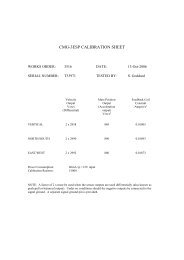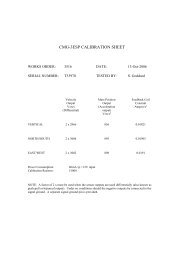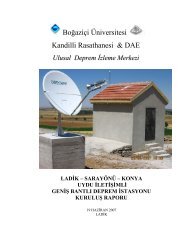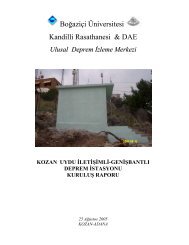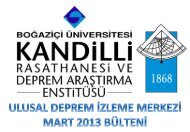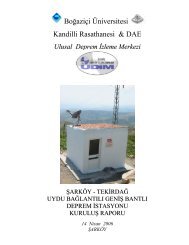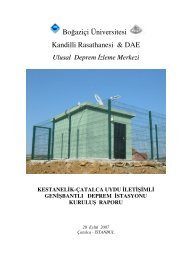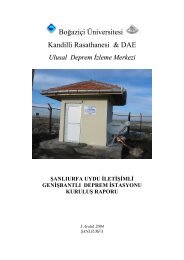NSM Handbook
NSM Handbook
NSM Handbook
You also want an ePaper? Increase the reach of your titles
YUMPU automatically turns print PDFs into web optimized ePapers that Google loves.
nsm<br />
FOUNDATIONS OF NON-<br />
STRUCTURAL MITIGATION<br />
nsm<br />
AFTER <strong>NSM</strong> . . .<br />
4<br />
This book is designed to help identify non-structural hazards in our<br />
homes, schools, work places, and public spaces and show how these<br />
hazards can be reduced. Non-structural elements are all the parts of a<br />
building, its furnishings and contents, except the structure itself. In<br />
other words, they are everything but the columns, beams, floors, loadbearing<br />
walls, roof and foundation.<br />
During an earthquake, some non-structural elements can pose danger<br />
to people or be damaged. We call the possibility of this danger or<br />
damage non-structural hazard.<br />
“What’s the<br />
point of<br />
worrying<br />
about nonstructural<br />
risk, don’t<br />
most<br />
buildings<br />
completely<br />
collapse<br />
anyway?”<br />
The best way to find out if your home will be strong in<br />
an earthquake is by having an engineer inspect your<br />
building. However, it is important to realize that only<br />
5% of the damaged buildings in the 1999 Izmit and<br />
Duzce Earthquakes totally pancake collapsed. In many<br />
heavily and moderately damaged buildings and even in<br />
some slightly damaged buildings, non-structural<br />
hazards accounted for serious injuries and huge<br />
economic losses.<br />
Of the 1,500,000 people directly affected by these<br />
earthquakes, 1% lost their lives. While losing these<br />
people was an incredible tragedy, the remaining 99%<br />
of residents were left to try to resume living after the<br />
earthquake.<br />
Taking precautions like those suggested in this<br />
handbook is one way that we can prepare for the next<br />
earthquake. These precautions will help make<br />
resuming life afterwards easier and quicker and will<br />
reduce economic loss. More importantly, they will<br />
reduce the number of lives lost. Even preventing small<br />
injuries allows priority to be given to those that are life<br />
threatening and helps to save lives.<br />
Erdik, Mustafa. Report on 1999 Kocaeli and Düzce (Turkey) Earthquakes. İstanbul:<br />
Boğaziçi University, Dept. Of Earthquake Engineering, 2000.<br />
Petal, Marla. Causes of Deaths and Injuries in the August 17th, 1999 3:02 a.m.<br />
M=7.4 Kocaeli Earthquake, Research Report, Boğaziçi University, CENDIM,<br />
Istanbul, 2003.<br />
<strong>NSM</strong> is still a new subject and new things are learned every day all over the<br />
world. This learning process has already started in Turkey. People who see<br />
the importance of <strong>NSM</strong> have begun mitigating hospitals, museums and their<br />
own homes and workplaces. These pioneers have not only learned ways to<br />
improve <strong>NSM</strong>, they have also learned the importance of maintaining their<br />
work and making <strong>NSM</strong> a way of life.<br />
As problems occur, they should be seen as clues to better solutions,<br />
rather than as failures.<br />
• When plastic clip and strap fasteners first started being used in<br />
Turkey, it was found that they were easy to leave open. Because of<br />
this, an improved locking fastener was produced.<br />
• After seeing that suspended ceilings broke apart and fell during<br />
earthquakes in the United States of America, it was clear that the<br />
methods used for attaching them were not sufficient. These<br />
methods have also been improved and tested through a series of<br />
earthquakes.<br />
• Self-adhesive fasteners have come unattached after use and wear.<br />
This has made everyone more aware of the importance of inspection<br />
and maintenance.<br />
In everything we do, we need to continue to ask how we can improve.<br />
In order for <strong>NSM</strong> to be successful, everyone must be educated and part of<br />
the process. The measures taken will become ineffective and quickly fall<br />
into disuse if they are considered to be a hindrance to the flow of daily life.<br />
The responsibility for addressing this issue falls upon the installers of <strong>NSM</strong>.<br />
It is very important to explain how and why measures can help protect our<br />
lives and include everyone in the decision making process during<br />
installation. This will create users that become advocates for their<br />
permanence.<br />
Everyone who learns about this topic realizes that their job is not finished<br />
after simply doing <strong>NSM</strong>. We recognize that this will become a part of our<br />
lives. At regular intervals we will need to check our fasteners. When<br />
rearranging or buying furniture we will need to consider how we will secure<br />
it and buy the necessary materials. While these new habits may come with<br />
difficulty at first, with time we will become accustom to them and making<br />
things safer will become automatic. As we share this knowledge and<br />
expertise with those around us and our information increases, even more<br />
attractive and easy solutions will emerge.<br />
Non-structural mitigation is a shared responsibility. After earthquakes<br />
occur, all of our observations and thoughts regarding improvements will<br />
help our knowledge to grow. In order to make our communities more<br />
resilient in the face of this type of disaster, everyone must play a role.<br />
33



